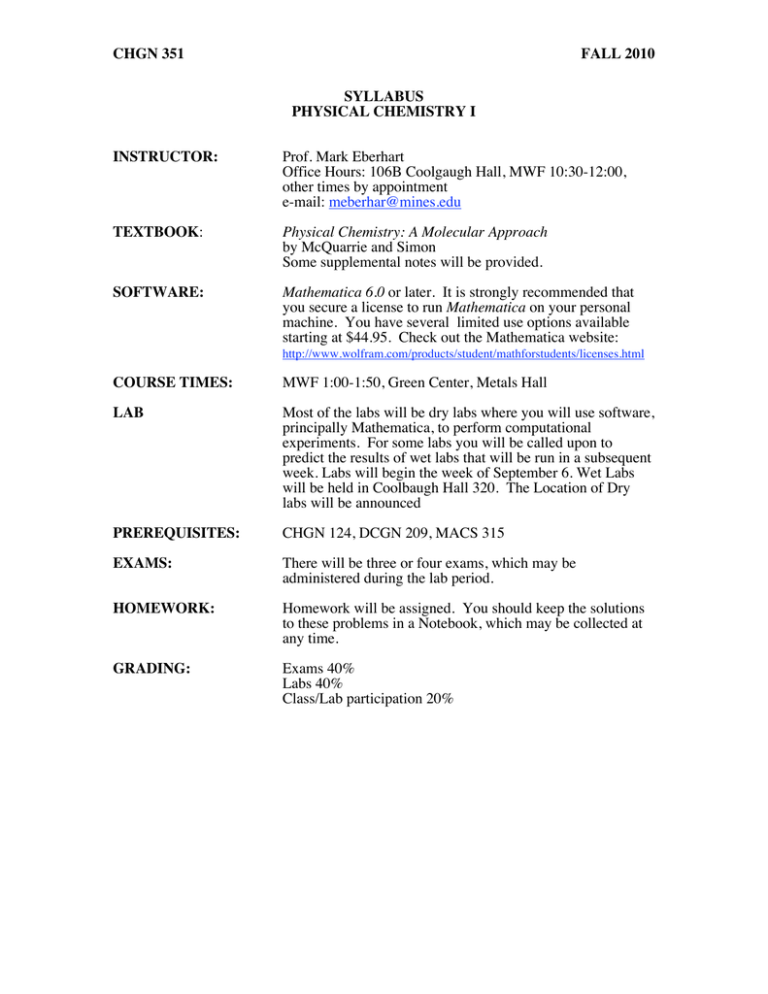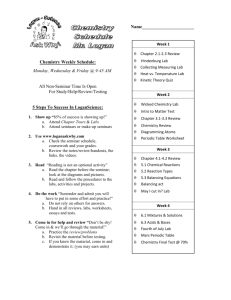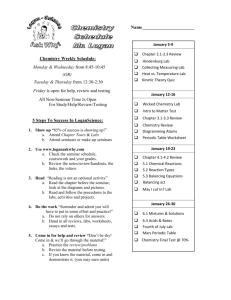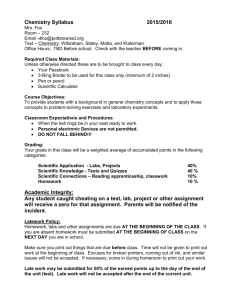CHGN 351 FALL 2010 SYLLABUS PHYSICAL CHEMISTRY I
advertisement

CHGN 351 FALL 2010 SYLLABUS PHYSICAL CHEMISTRY I INSTRUCTOR: Prof. Mark Eberhart Office Hours: 106B Coolgaugh Hall, MWF 10:30-12:00, other times by appointment e-mail: meberhar@mines.edu TEXTBOOK: Physical Chemistry: A Molecular Approach by McQuarrie and Simon Some supplemental notes will be provided. SOFTWARE: Mathematica 6.0 or later. It is strongly recommended that you secure a license to run Mathematica on your personal machine. You have several limited use options available starting at $44.95. Check out the Mathematica website: http://www.wolfram.com/products/student/mathforstudents/licenses.html COURSE TIMES: MWF 1:00-1:50, Green Center, Metals Hall LAB Most of the labs will be dry labs where you will use software, principally Mathematica, to perform computational experiments. For some labs you will be called upon to predict the results of wet labs that will be run in a subsequent week. Labs will begin the week of September 6. Wet Labs will be held in Coolbaugh Hall 320. The Location of Dry labs will be announced PREREQUISITES: CHGN 124, DCGN 209, MACS 315 EXAMS: There will be three or four exams, which may be administered during the lab period. HOMEWORK: Homework will be assigned. You should keep the solutions to these problems in a Notebook, which may be collected at any time. GRADING: Exams 40% Labs 40% Class/Lab participation 20% CHGN 351 FALL 2010 COURSE OUTLINE We will move at pace dictated by the class. If there are no questions during lecture, I will assume that the material is fully understood and we will move right along. If there are questions, those will be addressed before introducing new material. Under this structure, it is difficult to anticipate our week-by-week schedule. However, for planning purposes this is what you might expect. I. Overview of Physical Chemistry’s Basics (1 week) Notes A. Heat Capacity—the equipartition theorem B. Energy distribution in a quantum world II. Quantum chemistry—Chapters 1-5 (7 Weeks) A. Postulates of quantum mechanics and application to simple systems. B. Classical wave motion and normal modes C. The Schrödinger Equation and: The Particle In a Box, Rigid Rotator, and Harmonic Oscillator III. Statistical Thermodynamics—Chapters 16-18 (5 Weeks) A. Review of classical thermodynamics and fundamental postulates B. Derivation of Boltzmann’s entropy C. Ensemble theory and the canonical ensemble D. Heat Capacity Revisited



